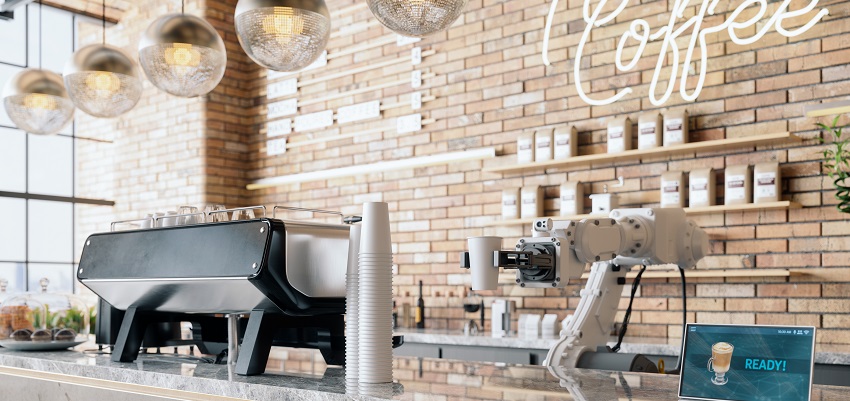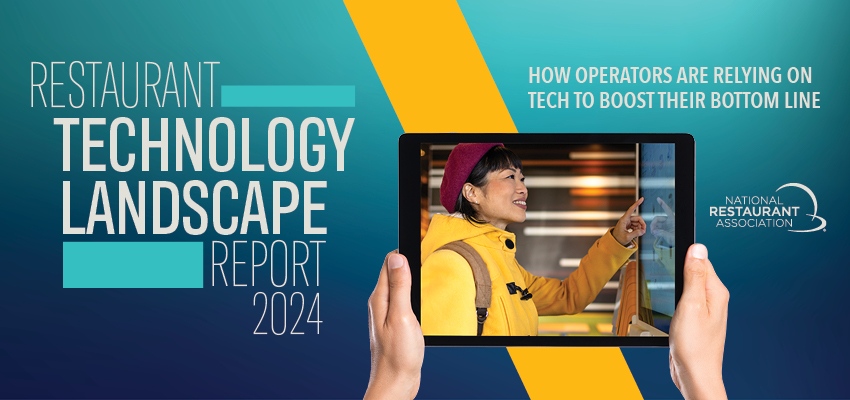Articles
October 10, 2024
Make room for restaurant automation
Automation and robotics are showing up in a number of ways, from hiring and training to delivering orders and bussing dishes.

Technology in restaurant and foodservice industry is evolving quickly and is more sophisticated than ever.
The global food automation market is projected to reach $28 billion by 2026 and the restaurant industry is experiencing a major shift, increasingly relying on technology to enhance productivity, reduce operational inefficiencies and increase employee retention. Like any new technology, what starts out as “out there” can become par for the course in increasingly shorter periods of time.
Here are some actionable steps to help navigate this technological revolution while maintaining the human touch that defines the hospitality experience.
Getting started: Assessing current operations
According to the National Restaurant Association's 2024 State of the Restaurant Industry report, 47% of operators anticipate that technology and automation will become more common to address labor shortages. The first step towards this involves analyzing your restaurant’s operations to identify the areas that could benefit from automation. Good exercises include:
Restaurant operators are leveraging artificial intelligence and other technologies to help them attract, vet and onboard good employee candidates. Applicant tracking systems (ATS) are software tools that help automate and manage the recruiting process, cutting out time-consuming tasks—like writing job ads, sorting through applications, tracking candidates and scheduling interviews.
The system allows recruiters (often, managers) to focus on interviewing, assessing and hiring the best candidates. Some systems even use AI assistants to take care of screening applicants to ensure they have the basic requirements for the job before advancing to the live interview stage.
“Look for an ATS that’s tailored to what individuals searching for jobs in the foodservice industry want,” says Arlene Estrada Petokas, chief people officer of Kura Revolving Sushi Bar. Applicants need the apps to be easy to use, quick-responding, and to have multi-language capability, for example.
Technology in this space is evolving quickly and is more sophisticated than ever. Read about five more tech solutions to automate the hiring process.
Streamline kitchen operations with automation
In an environment where speed and consistency are paramount, automation has proven to be a game-changer. By integrating automated systems into kitchen operations, restaurants can significantly improve efficiency.
More recently, Chipotle Mexican Grill began testing its Autocado (an avocado processing cobotic—person + machine—prototype) and the Augmented Makeline (a cobotic makeline) in two restaurants.
Use automation for employee safety and skill enhancement
Focus on implementing technologies that improve workplace safety and allow employees to focus on higher-value tasks. This approach can lead to reduced turnover and increase job satisfaction.
Balancing automation and human touch
The goal of any tech investment is not to replace staff, but to support them. In the National Restaurant Association's 2024 State of the Restaurant Industry report, 69% of operators believe that technology will augment rather than replace human labor, emphasizing the importance of balancing automation with human skills.
Here are some actionable steps to help navigate this technological revolution while maintaining the human touch that defines the hospitality experience.
Getting started: Assessing current operations
According to the National Restaurant Association's 2024 State of the Restaurant Industry report, 47% of operators anticipate that technology and automation will become more common to address labor shortages. The first step towards this involves analyzing your restaurant’s operations to identify the areas that could benefit from automation. Good exercises include:
- Tracking time spent on repetitive tasks in the kitchen and front-of-house
- Identifying bottlenecks in your preparation and service processes
- Surveying employees about the tasks they find most tedious or physically demanding
- Analyzing your current technology infrastructure to identify what needs refreshing (and at the same time, identifying potential integration points between elements of your tech stack so that systems work with each other).
Restaurant operators are leveraging artificial intelligence and other technologies to help them attract, vet and onboard good employee candidates. Applicant tracking systems (ATS) are software tools that help automate and manage the recruiting process, cutting out time-consuming tasks—like writing job ads, sorting through applications, tracking candidates and scheduling interviews.
The system allows recruiters (often, managers) to focus on interviewing, assessing and hiring the best candidates. Some systems even use AI assistants to take care of screening applicants to ensure they have the basic requirements for the job before advancing to the live interview stage.
“Look for an ATS that’s tailored to what individuals searching for jobs in the foodservice industry want,” says Arlene Estrada Petokas, chief people officer of Kura Revolving Sushi Bar. Applicants need the apps to be easy to use, quick-responding, and to have multi-language capability, for example.
Technology in this space is evolving quickly and is more sophisticated than ever. Read about five more tech solutions to automate the hiring process.
Streamline kitchen operations with automation
In an environment where speed and consistency are paramount, automation has proven to be a game-changer. By integrating automated systems into kitchen operations, restaurants can significantly improve efficiency.
- If you haven’t already, invest in old-school but effective automated food preparation tools (e.g., vegetable choppers, portion control dispensers, digital thermometers that generate temperature logs/send alerts).
- Implement digital kitchen display systems to streamline order production and look into kitchen displays that train/walk employees through tasks in real time.
- Explore precision cooking technologies—technologies that automatically cook foods to the perfect internal temperature—to improve consistency and quality. Sous-vide is an example.
- Explore robotic cooking assistants for repetitive tasks like frying or grilling, dining room dish delivery/bussing.
More recently, Chipotle Mexican Grill began testing its Autocado (an avocado processing cobotic—person + machine—prototype) and the Augmented Makeline (a cobotic makeline) in two restaurants.
Use automation for employee safety and skill enhancement
Focus on implementing technologies that improve workplace safety and allow employees to focus on higher-value tasks. This approach can lead to reduced turnover and increase job satisfaction.
- Identify hazardous, repetitive, or physically demanding tasks that can be automated.
- Provide comprehensive video training for employees on how to operate and maintain new technologies that can be repeatedly reviewed/accessed.
- Use automation to free staff to engage in more customer-facing or customer experience-enhancing roles.
- Develop career pathways for employees with tech skills.
- Encourage chefs to use precision cooking technologies in new recipe creation so that control and consistency requires less human oversight or expertise.
- Use data from automated systems to inform quantity production by daypart, weekday and season.
- Implement AI-driven analytics to identify emerging food trends and customer preferences.
Balancing automation and human touch
The goal of any tech investment is not to replace staff, but to support them. In the National Restaurant Association's 2024 State of the Restaurant Industry report, 69% of operators believe that technology will augment rather than replace human labor, emphasizing the importance of balancing automation with human skills.
Gold Sponsor
-
Samsung DisplayAs a global technology leader, the Samsung Display Division is committed to helping customers realize the promise of a digital business with a diverse portfolio of enterprise technologies including Smart Signage, LED Screens, Video walls, and Monitors. Samsung puts the customer at the core of everything we do by delivering comprehensive products, solutions and services across diverse industries. For more information, please visit samsung.com/business.Learn More
Supported by
-
ParadoxParadox is the conversational recruiting software behind the world’s first Conversational ATS. Paradox is helping recruiters and hiring managers save hours every day on manual tasks by automating candidate screening, interview scheduling, and reminders, while delivering a world-class, frictionless and consumer-like mobile candidate experience.Learn more
We serve some of the industry's leading clients, including Chipotle, Darden, Flynn, Focus Brands, Bloomin' Brands, Peet's Coffee, Taco Bell, Dunkin' and more.
Download the report
Download the report
Sign up for our Newsletter
The latest news from the National Restaurant Association, published every other Thursday
By clicking Submit I agree to receive email communications from the National Restaurant Association and agree to our Privacy Policy(Opens in a new window).


